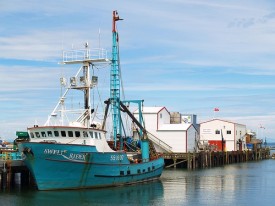This primer is also available in a two-page summary format.
Tiny sea butterflies dissolve before researchers’ eyes. Baby oysters die by the tankful. Sea urchins grow deformed. These are a few consequences of raising marine creatures in increasingly corrosive water. And they could preview what’s in store for the Northwest as carbon dioxide pollution from cars, power plants, and other human sources changes the chemistry of our marine waters.
Oceans—and their salt-water extensions like Puget Sound—play an enormous role in our region’s prosperity. A new report from Sightline—Northwest Ocean Acidification: The Hidden Costs of Fossil Fuel Pollution—details how years of addiction to fossil fuel pollution are putting that resource at risk.
You can read the full report here, but here are some basics:
What is ocean acidification?
Every day, the oceans do us a huge favor by absorbing a third of the carbon dioxide we release into the atmosphere—emissions that would otherwise make global warming worse. But rising fossil fuel pollution has another cost: as oceans absorb more carbon dioxide, they become more acidic and corrosive. The process also robs seawater of carbonate ions, a key building block for shells and skeletons and an ingredient so essential to ocean life that some call it “the soil of the marine world.”
Is it happening now?

Just five years ago, scientists believed the effects of ocean acidification would be confined to deep, offshore ocean waters for decades—until oceanographers started hunting for it off the Pacific Coast. In the last few years, they’ve found evidence of acidification nearly everywhere they looked, from British Columbia to Baja California to Washington’s Puget Sound.
What can the Northwest expect?
Some creatures will do fine in a more corrosive ocean. Others will die. In laboratory experiments, the animals that struggle or dissolve range from mussels to endangered abalone to cornerstones of the marine food web like krill and pteropods—tiny sea snails that make up more than half of the diet of some young Alaskan pink salmon. Yet some crustaceans have developed thicker shells, and some eelgrass grew more abundantly. Northwest researchers are working hard to understand how important local species will fare.
What are the potential economic consequences?

Among commercially valuable species, shellfish appear to be the most vulnerable. In recent years, two of the Northwest’s three major oyster hatcheries have had massive die-offs, some of which have been linked to acidified seawater. In Washington’s Willapa Bay, oysters have largely failed to reproduce in the wild for the last six years.
It’s unclear whether ocean acidification will directly affect salmon or pollock or other prized finfish, but it could disrupt food webs and make their prey less abundant. The executive director of Alaska’s largest commercial fishing organization, Mark Vinsel, ranked his concerns about ocean acidification this way: “I’d say probably on a scale of 1 to 10, it would be 20 or 30.”
What can we do about ocean acidification?
- Reduce damaging emissions by approving policies that limit or put a price on carbon dioxide pollution.
- Use existing laws to curb pollutants that worsen the impacts of acidification.
- Invest in research and monitoring to determine how species will be affected, better manage fisheries, protect important habitat, and help seafood producers adapt.
[button link='{“url”:”http://www.sightline.org/research/energy/ocean-acidification/northwest-ocean-acidification”,”title”:”Download the report.”}’ color=”orange”]


Comments are closed.